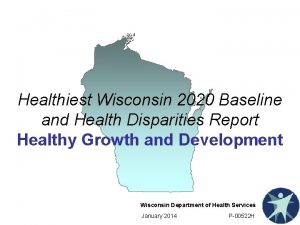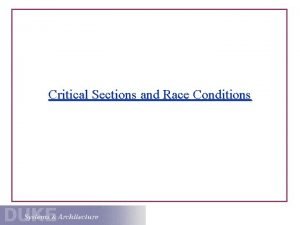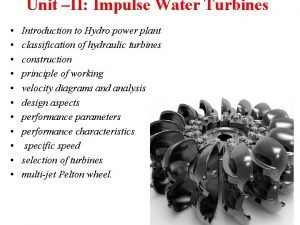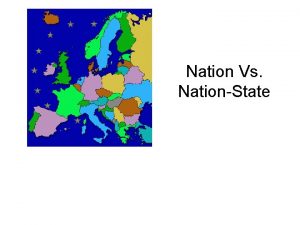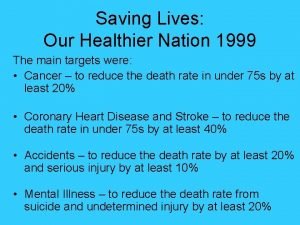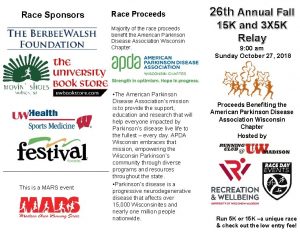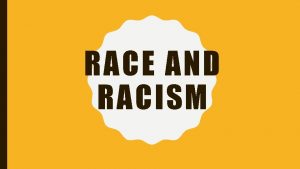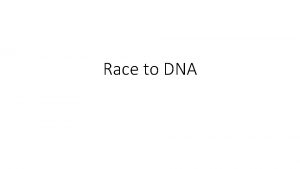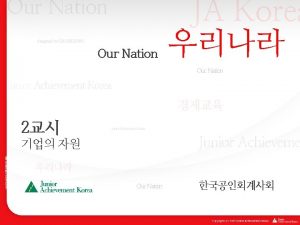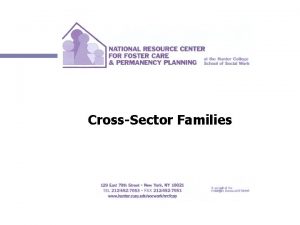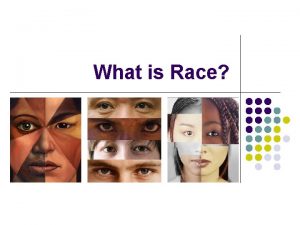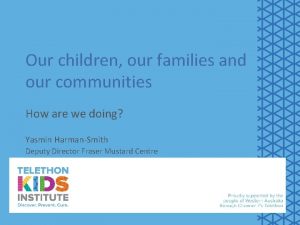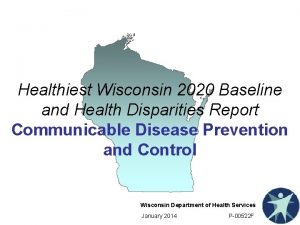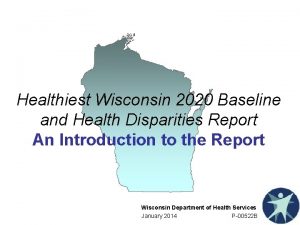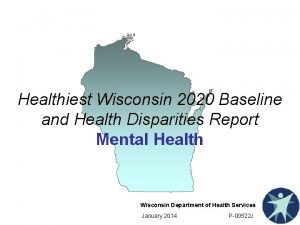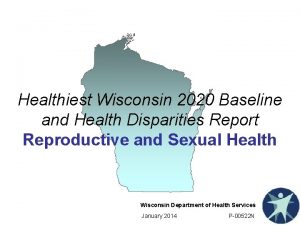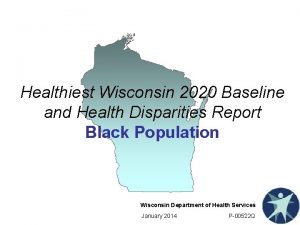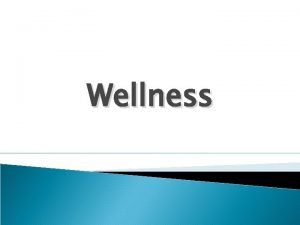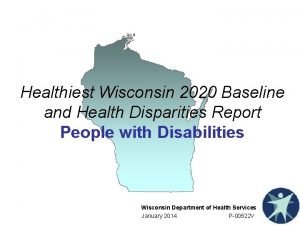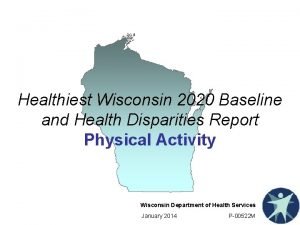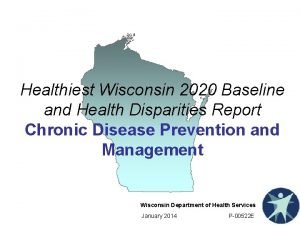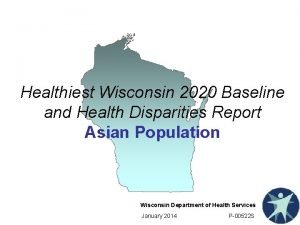Race to the Healthiest Nation How Our Families


































- Slides: 34


Race to the Healthiest Nation How Our Families, Communities and Workplaces Can Help Make Us Fit Global. Fit’s 3 rd Annual Worksite Wellness Summit May 14, 2009 Philadelphia, PA L. Casey Chosewood, MD Centers for Disease Control and Prevention 2

Disclaimer • The mention of organizations and commercial entities and products in this presentation is for illustrative purposes only and does not represent an endorsement by CDC or the US Department of Health and Human Services. • The views herein represent those of the author and presenter and not official cleared guidance from the Centers for Disease Control and Prevention (CDC). 3

Let’s Talk Health of the Nation What does HEALTH mean to me?

The U. S. Has a Critical Shortage of Health The U. S. spends > $2 trillion every year on healthcare, more than any other country. • Among industrialized countries, we rank no higher than 15 th in health status (disability-adjusted life expectancy) • Among all countries of the world, the U. S. ranks: • 35 th in infant mortality prevention • 30 th in life expectancy at birth “We spend less than four cents of every health care dollar on prevention and public health even though eighty percent of the risk factors involved in the leading causes of death are behavior-related and thus preventable. ” – President Obama 5

The U. S. Has a Critical Shortage of Health • The US is one of the leading countries for cancer risk-largely due to tobacco • Coronary heart disease rates are high, diabetes rates and risk factors are increasing • High levels of violence-related death are present • Leading causes of premature death: tobacco, poor diet and physical inactivity, alcohol, microbial agents, toxic agents, motor vehicle crashes, firearm-related incidents, sexual behaviors, drugs 6

Why Is The U. S. Not The Healthiest Nation? • • We are not getting the best value for what we are spending • • Health doesn’t happen in the doctor’s office or hospital • We do not invest enough in protecting health: 15 preventable medical conditions are responsible for nation’s health costs increases Health happens in our homes, schools, workplaces and communities • • • Promoting good health Preventing disease, injury, and disability Preparing for new health threats 7

Americans’ Views on Healthcare system satisfaction • • Republicans Democrats Rates “fair” or “poor” 51% Requires fundamental change or rebuilding 77% 93% Satisfied with cost 32% 10% Satisfied with quality 58% 20% Worries • • Will have to pay more 66% Blendon RJ et al: Health Care in the 2008 Presidential Primaries. NEJM 358; 4 2008 80% 8 Will lose insurance 43% 79%

LET’S TALK HEALTH EQUITY 9

An Ethical Imperative: Social Determinants of Health “Social injustice is killing people on a grand scale. ” • • In the United States, from 1991 -2000: • • 176, 633 lives were saved by modern medical advances 886, 202 deaths would have been averted in this same time period if mortality rates between white and African Americans had been equalized. The poorer you are, the worse your health outcomes Source: WHO Commission on Social Determinants of Health - Final Report 10

Urgent Realities Preventable Extreme diet chronic diseases are an epidemic in Extreme environment America today. Extreme aging Extreme convenience 11

Urgent Realities • About 75 percent of the $2. 2 trillion the United States spends on healthcare goes toward treating chronic conditions like diabetes, heart disease, and cancer. 1 • That $2. 2 trillion works out to $7, 421 person. Out-ofpocket costs are $889 per American, a 5. 3 percent increase over 2006 1 • One in 4 Americans has delayed medical care within the past 12 months because of cost • Average cost for family health insurance coverage is $12, 000 per year Sources: 1 - Centers for Medicare and Medicaid Services 12

Urgent Realities • 133 million Americans, 45% of the total population, have at least one chronic disease 1 • It is projected that 388 million people will die worldwide from chronic disease in the next 10 years. 2 • An investment of $10 person per year in proven community-based programs to increase physical activity, improve nutrition, and prevent smoking and other tobacco use could save the country more than $16 billion annually within five years. 3 Sources: 1 - Wu S, Green A. Projection of Chronic Illness Prevalence and Cost Inflation. RAND Corporation, October 2000. 2 - Pricewaterhouse. Coopers, Working Towards Wellness. Feb 2007 Report 3 - Trust for America’s Health 13

Is the “Care” in Healthcare Over-Emphasized? Expensive Care – costs extraordinarily high -16% of annual gross domestic product (GDP) or about $6, 400 person Access to Care – 45 -47 million Americans are uninsured; geographic and other barriers to access; loss of primary care homes and emphasis; provider shortages; pre-existing conditions Quality of Care – over- and under-utilization of services; medical errors Quick Quiz: Compared to one generation ago, how much would a dozen eggs cost today if they had 14 risen in price at the same rate as healthcare?

Quick Quiz Answer $80. 25 (that’s $6. 69 per egg) 15

Poly. Pill: Miracle or Myth? • “…proponents say could reduce blood pressure and cholesterol levels -two well-known heart disease risk factors -- significantly for some, according to research presented today at the American College of Cardiology's 58 th annual scientific session in Orlando. ” 1 • Combines multiple drugs into a single pill taken once per day • 3 blood-pressure lowering drugs • 1 cholesterol-lowering “statin” drug • aspirin • Concerns: • Balance Sheet Dieting – “I’ll have a cheeseburger, diet soda, and polypill, please…” • Potential paradigm shift from treating individuals to generalized risk groups • “the number of medications included in the pill makes tailored treatment impossible. . . ” 2 • Loss of personal responsibility? 1. 2. 16 Dan Childs, ABC News, 30 MAR 09 Dr. Robert Bonow, past president of the American Heart Association

Isn’t Behavioral Change Enough? Sir Michael Marmot “ It is unreasonable to expect people to change their behavior when the social, cultural and physical environments around them fully conspire against them…. ” Adapted from M. Marmot/Institute of Medicine Report 17

It’s Time to Think and Act Differently About Health • • Shift the focus from healthcare to well-being • • Join forces at local, state, national levels to work together for health Encourage grassroots action and empower people to demand change Provide specific action ideas for creating the healthiest home, healthiest city, etc. Change how we define a successful health system –track measures of health rather than disease • • Create physical, social, and economic conditions that promote health and embrace prevention 18

Let’s Talk Health of the Nation Can we be the HEALTHIEST nation? 19

• • • Becoming “Choice Architects” Choice-making is never neutral Directing default options toward health can be powerful Subtle “nudges” toward healthier choices can better outcomes Policy interventions provide the basis for better choices Incentives and spotlights can motivate Provide structure around complex choices Themes from Thaler R, Sunstein, C: Nudge Improving Decisions About Health, Wealth, and Happiness, 2008.

New for 2008! Physical Activity Guidelines for Americans Toolkit Be Active, Healthy, and Happy! • www. health. gov/PAguidelines • Be Active Your Way: Fact Sheet and Guide for Adults • PA Guidelines for Americans Toolkit User’s Guide o At-A-glance: A Fact Sheet for Professionals o FAQs o Federal Resources for More Information and Ideas 21

Are you Meeting the New 2008 Physical Activity Recommendations for Adults and Children? • Adults • At least 2 and ½ hours a week of moderate intensity aerobic physical activity • Or 1 hour and 15 minutes of vigorous physical activity • Increase to 5 hours a week moderate or 2 and ½ hours weekly of vigorous physical activity • Older Adults • Older adults should follow same adult guidelines as ability and condition allows • Concentrate on exercises that maintain or improve balance if needed • Children and Adolescents • At least 1 hour or more of moderate/vigorous aerobic physical activity everyday • Vigorous intensity activity at least 3 days a week 22

Are you Meeting the New 2008 Physical Activity Recommendations for Special Populations • Women during Pregnancy • Healthy women should get at least two and ½ hours of moderate-intensity aerobic activity a week • Vigorous activity allowed if active before pregnancy and under guidance of healthcare provider • Adults with Disabilities • Should follow same adult guidelines as ability allows • Incorporate muscle-strengthening activities two or more days a week • People with Chronic Medical Conditions • Should follow same adult guidelines as ability allows • Should do so with the guidance of a health care provider 23

A Health System for A Healthiest Nation: Health Protection for Life! Public Health Network Health Protection: Health Promotion, Prevention, and Preparedness Healthcare Delivery System Disease Care 24

Workplace Health Investments in Prevention $$$ to the Bottom Line • Worksite health promotion programs yield an average return on investment of nearly $4 for each $1 spent on direct health care costs(1) • Reduce the cost of absenteeism by $5 for every $1 spent(1) • A review of 42 published studies of worksite health promotion programs shows: • Average 28% reduction in sick leave absenteeism • Average 26% reduction in health costs • Average 30% reduction in workers compensation and disability management claims costs • Average savings of $5. 93 for every $1 spent(2) • Common Flu causes - 70 million missed work days(3) per year Sources: 1. Anderson, E. Wellness Councils of America, 2002 2. Aldana SG. Financial impact of health promotion programs: a comprehensive review of the literature. Am J Health Promotion. 2001; 15(5): 296 -320 3. Challenger, Gray & Christmas Inc. 25

Global. Fit. TM and CDC Partnership • Working together for more than 5 years • Complements our onsite fitness programming • Benefit extends to families and contractors • With Global. Fit we provide more than 98% of CDC employees access to free or low-cost fitness facilities • No-cost contract mechanism 26

Go Green! Get Healthy! • Launched in 2007 • Combines personal health promotion and environmental awareness efforts • Improve • workplace morale • staff and agency resiliency • care for employees • Leadership role modeling • environmental responsibility • corporate citizenship 27

Family/workplace interventions 28

Summary • • • The health and healthcare challenges we face are daunting The solution requires a paradigm shift from merely treating disease to promoting health and well-being before disease begins Greater investments in health protection are necessary Success comes from empowered individuals and organizations dedicated to true health system transformation Policy and equity interventions combined with meaningful measures of health are critical It’s time to act now—together we can accomplish more 29 …In support of Healthiest Nation

Resources • Healthy People 2010 – Healthy People 2020 • www. healthypeople. gov/ • • www. healthiestnation. org • Smallstep Global. Fit. TM • http: //www. globalfit. com/corp/ • Guide to Community Preventive Services • http: //www. thecommunityguide. org/ • Go Green! Get Healthy! • http: //www. cdc. gov/about/stateofcdc/h tml/2008/About 05 Green. htm • NIOSH Work. Life Initiative • http: //www. cdc. gov/niosh/worklife/ • • Alliance to Make US Healthiest • http: //www. smallstep. gov/ • Community Toolbox • http: //ctb. ku. edu/en/ • CDC’s Healthiest Nation Efforts • http: //www. cdc. gov/about/Nation/health iest. Nation. htm • APHA - Healthiest Nation in 1 Generation • http: //www. generationpublichealth. org/ HHS Physical Activity Toolkit: http: //www. health. gov/PAGuidelines/toolkit. aspx

31

One Model for a Healthier US Means Ways Research Business Private Faith-based Orgs Public Figures Public Health Youth Movements Civic/Social Groups Unions/Labor • Community and Workplace Health Indexes • Cultural Change ASTHO A Nation Invested in Prevention and Health Promotion • Social Networking and Technology • Partnerships Education CDC End POLICY NGOs NACCHO • Social Networking COMMUNICATIONS & MARKETING People TARGETED INTERVENTIONS Philanthropic/ Foundations Academia • Individual Actions Media/Entertainment Legislators Healthcare Non-profits Advocacy Orgs Government • Health in All Policies 32

Alliance to Make US Healthiest Join now at www. healthiestnation. org 33

QUESTIONS? 34
 Healthiest wisconsin 2020
Healthiest wisconsin 2020 Dam
Dam Little families
Little families Data race vs race condition
Data race vs race condition Pelton turbine efficiency
Pelton turbine efficiency Pseudoscientific ideas of race on the jewish
Pseudoscientific ideas of race on the jewish Country vs nation
Country vs nation Nation vs state
Nation vs state State vs nation
State vs nation Ja our families
Ja our families Early chinese traders who visited mindoro called our nation
Early chinese traders who visited mindoro called our nation 21 february seen passage
21 february seen passage What is our healthier nation 1999
What is our healthier nation 1999 America history of our nation textbook
America history of our nation textbook Our nation textbook
Our nation textbook Who composed the poem ‘money madness’?
Who composed the poem ‘money madness’? Thinking affects our language which then affects our
Thinking affects our language which then affects our Our future is in our hands quotes
Our future is in our hands quotes We bow our hearts we bend our knees
We bow our hearts we bend our knees Awareness of ourselves and our environment is:
Awareness of ourselves and our environment is: Our census our future
Our census our future Our awareness of ourselves and our environment
Our awareness of ourselves and our environment Our census our future
Our census our future Awareness of ourselves and our environment is
Awareness of ourselves and our environment is Christ be our light shine in our hearts
Christ be our light shine in our hearts Our awareness of ourselves and our environment is called
Our awareness of ourselves and our environment is called Our life is what our thoughts make it
Our life is what our thoughts make it God our father christ our brother
God our father christ our brother Marcus aurelius our life is what our thoughts make it
Marcus aurelius our life is what our thoughts make it Hình ảnh bộ gõ cơ thể búng tay
Hình ảnh bộ gõ cơ thể búng tay Tỉ lệ cơ thể trẻ em
Tỉ lệ cơ thể trẻ em Vẽ hình chiếu đứng bằng cạnh của vật thể
Vẽ hình chiếu đứng bằng cạnh của vật thể ưu thế lai là gì
ưu thế lai là gì Phản ứng thế ankan
Phản ứng thế ankan Quá trình desamine hóa có thể tạo ra
Quá trình desamine hóa có thể tạo ra
